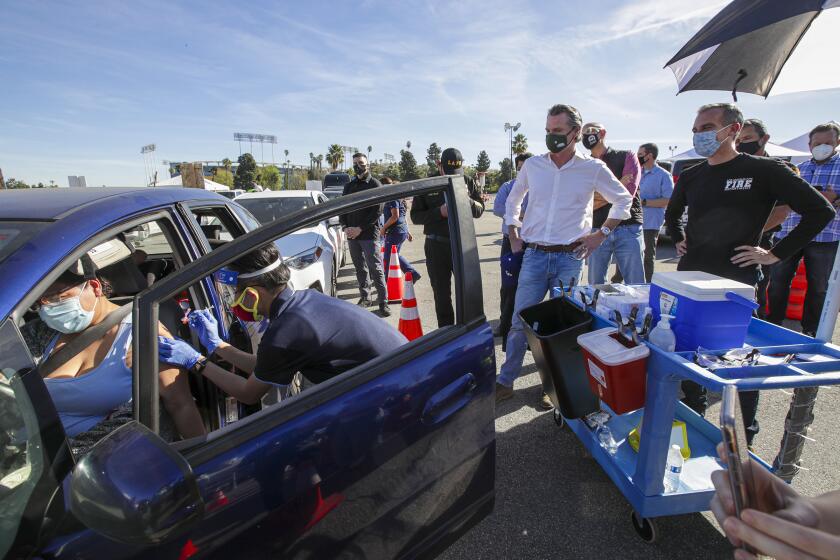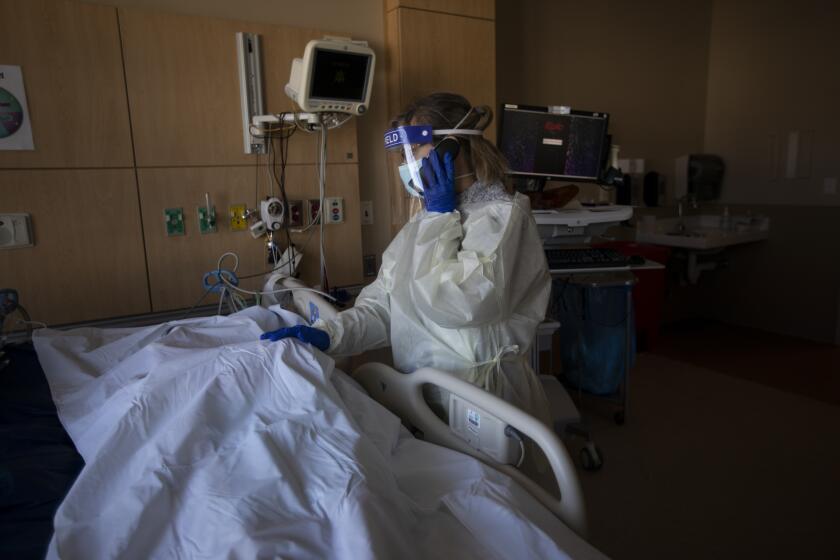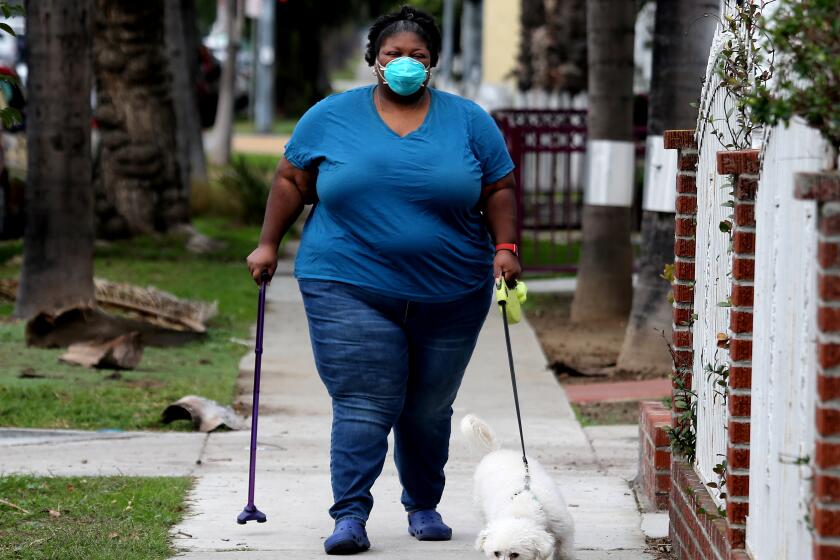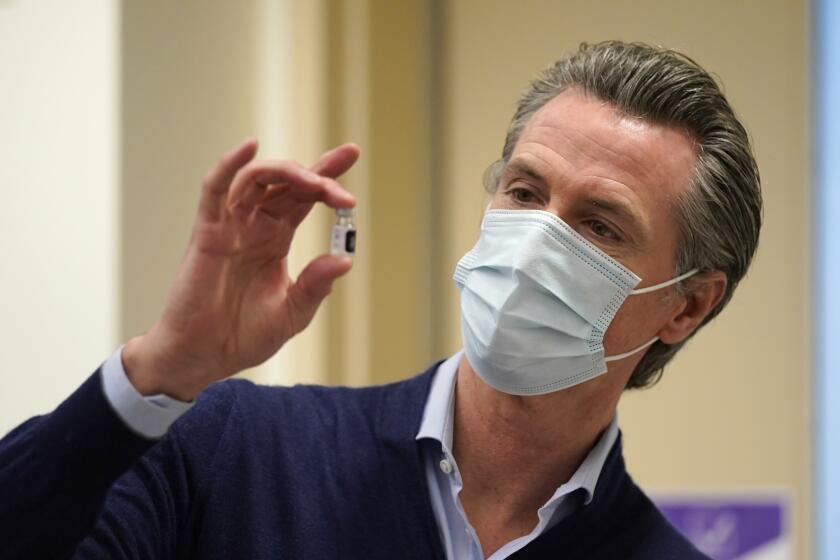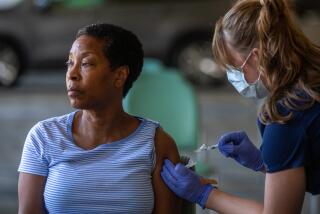Wondering when your second L.A. COVID-19 vaccine appointment is? Check your email
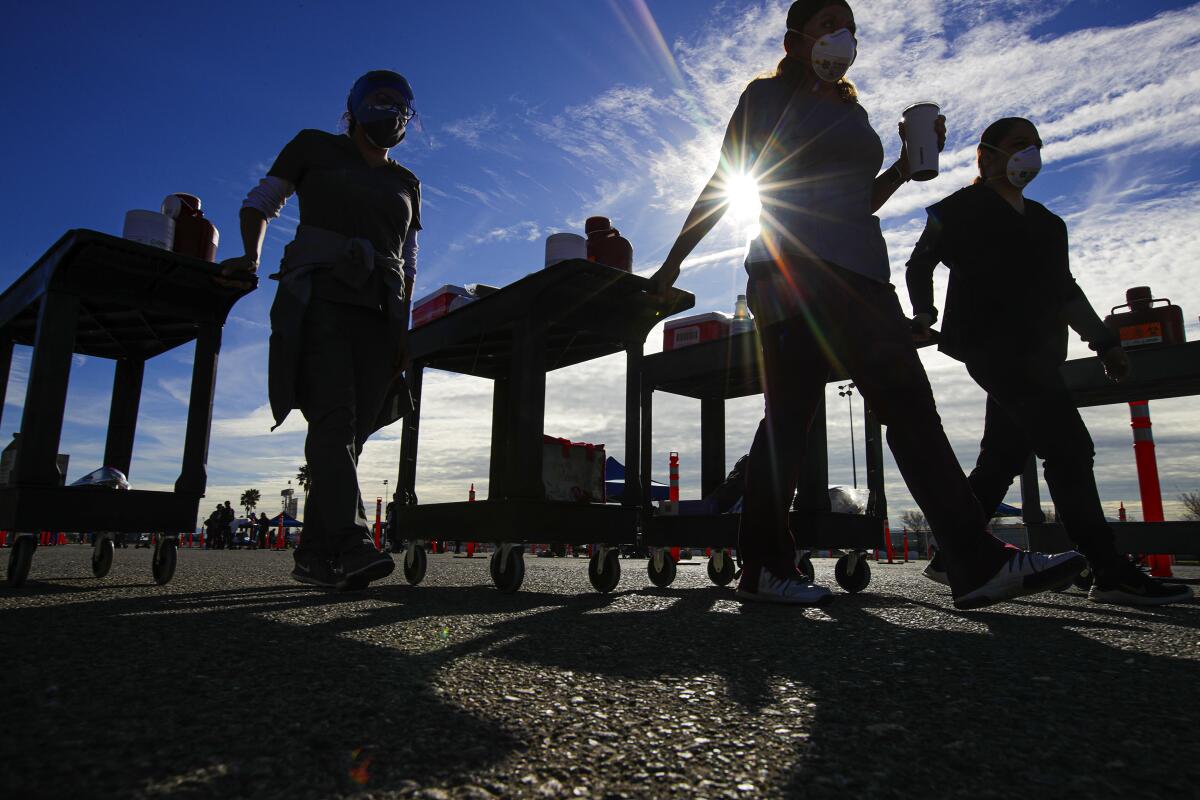
- Share via
Los Angeles County residents awaiting their second dose of COVID-19 vaccines should keep an eye on their email, officials said this week.
Those who received shots at a county-run vaccination site will get a direct message allowing them to confirm follow-up appointments, according to the county’s Department of Public Health.
People who were inoculated at a site run by the city of Los Angeles — such as Dodger Stadium — will automatically be scheduled for a second appointment, officials said, and should receive a text message and email with details.
County officials said most Angelenos will receive their second shots wherever they got their first dose, but it’s possible some residents will be instructed to go elsewhere.
Supply shortages. Data problems. A fragmented system of 61 local health departments. They all contributed to California’s lagging vaccination rate.
It is important that the second dose, wherever received, is the same vaccine as the first. For the Pfizer-BioNTech vaccine, the recommended wait time between shots is 21 days. For the Moderna vaccine, it’s 28 days.
“Please try to keep your appointments for the second dose,” county public health officials wrote Monday on Facebook. “If you need to reschedule due to an emergency, you will be provided with an email address to contact us. We know this process has been stressful and we deeply appreciate your patience.”
Those who were vaccinated at a pharmacy, community clinic or hospital should contact those facilities with questions about their second dose appointment.
“All vaccination sites receive enough second doses each week to schedule appointments for individuals who received their first dose at their site,” county Public Health Director Barbara Ferrer said during a briefing Monday. “I do apologize for the many hardships that people have been experiencing trying to secure appointments.”
More information is available at vaccinatelacounty.com and corona-virus.la/covid-19-vaccine.
Concerns over the availability of second doses, as well as the logistical challenges in scheduling them, are the latest issues in an at-times chaotic vaccine rollout that’s been plagued by shifting eligibility criteria, overloaded online appointment systems and other technical hiccups.
As pressing as those issues are, they’re secondary to what officials say is the biggest hurdle: an insufficient, and at-times unreliable, supply of shots.
“The supply of vaccine, we acknowledge that’s going to be our rate-limiting step,” Dr. Mark Ghaly, California’s health and human services secretary, said during a briefing Tuesday. “We always hope for more, we continue to work with the federal administration to push for more, but that will be one of our biggest challenges.”
Healthcare workers, first responders and residents and staff in skilled nursing facilities were the first groups eligible to receive the vaccine in California. That changed in mid-January, when Gov. Gavin Newsom expanded the pool to include people 65 and older.
While some greeted the news that older Californians — who have fallen severely ill and died from COVID-19 at distressingly disproportionate rates — were being given a place in line, the state’s move came amid dwindling doses, and sparked chaos and confusion as some counties moved quickly to allow seniors to enter their queues, while others did not.
In the first month of 2021, 6,411 people died of COVID-19 in Los Angeles County — 137% more than the previous most-deadly month of December.
Dramatically swelling the number of people eligible to be vaccinated also strained the availability of shots.
In L.A. County, older residents were able to schedule vaccine appointments beginning the week of Jan. 18, meaning second doses will have to start going out next week.
However, the number of doses the county receives has been inconsistent and trending downward. For the week of Jan. 11, L.A. County received 193,950 vaccine doses; the following week, it received only 168,575 doses and only 146,225 doses the week after that.
As of Jan. 25, the county had received nearly 1 million vaccine doses and administered almost 800,000.
Given the relatively scarce supply, vaccines will need to increasingly be set aside for second doses — leaving fewer shots for people looking to begin the regimen.
Last week, the L.A. County Public Health Department, acting at the request of the California Department of Public Health, “recovered” 10,000 doses from Ralphs pharmacies that were intended for upcoming appointments — allocating them instead to support the county’s mass vaccination sites.
While a spokesman for the supermarket chain said only people seeking their first dose would be affected and that those scheduled to get their second dose would still get their shots, the episode underscored how the need for second doses is overriding overwhelming demand for initial inoculations.
The move also added to confusion among residents over 65. According to the county, those who received their first shot at Ralphs before Jan. 27 will get a call or email from the pharmacy to schedule their second dose. Those inoculated after that date will be given appointments for their second dose when they get their first dose.
The vaccine shortage is not just in L.A., either. Kaiser Permanente was forced to cancel more than 5,000 appointments for seniors in Santa Clara County because of limited supplies.
For disabled and chronically ill Californians, Gov. Newsom’s decision to change COVID-19 vaccine priorities has sparked confusion and anger.
Despite the problems that have dogged the rollout, there are some signs that California may be starting to build momentum.
About 7.2% of Californians have received at least one dose, data compiled by The Times show. Nearly 61% of the state’s vaccine supply has been administered — a dramatic improvement from a week ago, but still behind other big states like Texas, Illinois and New York, and only slightly ahead of Florida.
Additional groups are also starting to get their shots. Cal State Long Beach started its vaccination program Tuesday, with the top priority being personnel working on campus and staff and faculty over 65 or who have high-risk medical conditions.
“These educators and staff have been working on campus, and we are getting folks vaccinated to ensure we can get our campus fully reopened safely,” Long Beach Mayor Robert Garcia wrote on Twitter.
Workers at the Union Rescue Mission on skid row also escorted some of their older homeless clients to be vaccinated Tuesday.
“They were very excited and relieved to have a chance to be vaccinated,” said the Rev. Andy Bales, president and CEO of the mission.
Bales said about seven men received their shots Tuesday, but the hope is to get 40 seniors — men and women — their first dose this week.
For a time, it appeared L.A.’s homeless population had largely escaped the ravages of the pandemic. But this latest surge was different and left no group in the hard-hit county unscathed.
“It’s been alarming,” Bales said. “And I know, for me, it’s felt like COVID-19 has been closing in around us, and really, it seems like it’s been figuring out its way around every precaution. I know that’s what a lot of our guests feel as well.”
Newsom approval plummeting with a third of voters support recall amid COVID-19 criticism, poll finds
More than a third of the state’s registered voters said they would vote to oust Newsom from office if the recall qualified for the ballot, though 45% said they would oppose such a move, a Berkeley IGS poll found.
Changes to California’s vaccine plan are also on the horizon. Officials announced last week that advisors to Newsom have struck an agreement with Blue Shield of California to oversee distribution of vaccine doses to counties, pharmacies and private healthcare providers.
Newsom has also announced that California will shift vaccine priority to an age-based eligibility structure — with the hope of creating a framework that’s easier to understand and quicker to implement.
Details of that overhaul remain scant. Ghaly said that the state is continuing to work through updating vaccine prioritization — and that additional details could be released in the next week. He emphasized, though, that equity will be a cornerstone of California’s approach.
“This notion that there’s a choice that we have to make between speed in vaccinations and equity, this is not a choice,” he said. “This is a false choice. We can do both.”
However, the concept of moving to an age-based formula has already drawn criticism from groups representing some essential workers and disabled people.
Though he didn’t offer specifics on what changes may be coming, Ghaly said “we are leading our vaccination effort by focusing on protecting those who have the highest risk and those who may suffer the worst consequences from COVID” and that the state is “working with the disability community, working with those who take care of individuals with serious chronic conditions, beginning to galvanize around a policy that we will announce later.”
Times staff writers Maya Lau, Laura J. Nelson, Colleen Shalby, Maura Dolan and Rong-Gong Lin II contributed to this report.
More to Read
Sign up for Essential California
The most important California stories and recommendations in your inbox every morning.
You may occasionally receive promotional content from the Los Angeles Times.
